Physical Address
304 North Cardinal St.
Dorchester Center, MA 02124
Physical Address
304 North Cardinal St.
Dorchester Center, MA 02124

Discover 22 stunning patio pergola ideas to transform your outdoor space. From classic wooden designs to modern metal structures, find the perfect pergola to create shade, privacy, and style for your backyard oasis.
Is your patio feeling a little…blah? Dreaming of a backyard escape that’s both stylish and functional? Look no further than the transformative power of a patio Pergola!
More than just a shade structure, a pergola is an architectural statement, a zone definer, and a blank canvas for your outdoor dreams. Whether you envision a sun-dappled dining area, a luxurious lounge space, or a verdant garden retreat, the perfect pergola is waiting to be discovered.
Get ready to be inspired as we unveil 22 stunning patio pergola ideas that will revolutionize how you experience your backyard. Prepare to be amazed!
A pergola works its magic through its ingenious lattice design. Unlike a solid roof, the spaced slats allow sunlight to filter through, creating beautiful dappled shade. This diffused light is much gentler than direct sun, significantly reducing the temperature and making your patio a much more pleasant place to be, even on the hottest days.
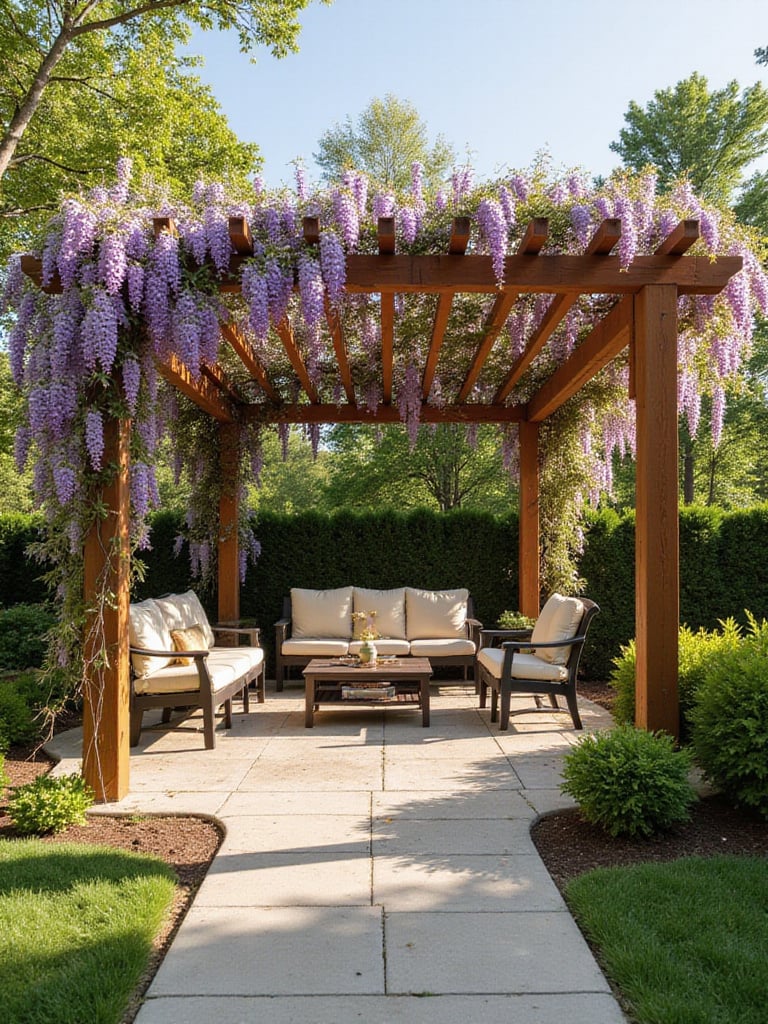
The beauty is that you’re not completely cut off from the sun; you still enjoy the warmth and light, just in a more comfortable and controlled way. You can even customize the level of shade by adjusting the spacing between the slats, or by adding climbing plants or shade sails for even denser coverage.
Here’s what makes pergolas stand out for shade: * Natural airflow prevents that stuffy, trapped-heat feeling * Customizable shade levels through slat spacing * Permanent structure that enhances landscape design * More stable than umbrellas, more open than awnings
Here’s where it gets interesting – the right pergola can transform your patio from a scorching hot zone to your favorite outdoor retreat, all while adding architectural interest to your home.
Think of a pergola as a subtle room divider for your patio. Its structure acts as a natural boundary, signaling a shift in purpose as you move from one area to another. Imagine stepping from an open sun patio into the shaded embrace of a pergola-covered dining area. The change in overhead structure subtly defines the space, making it feel intentionally designed for a specific purpose.
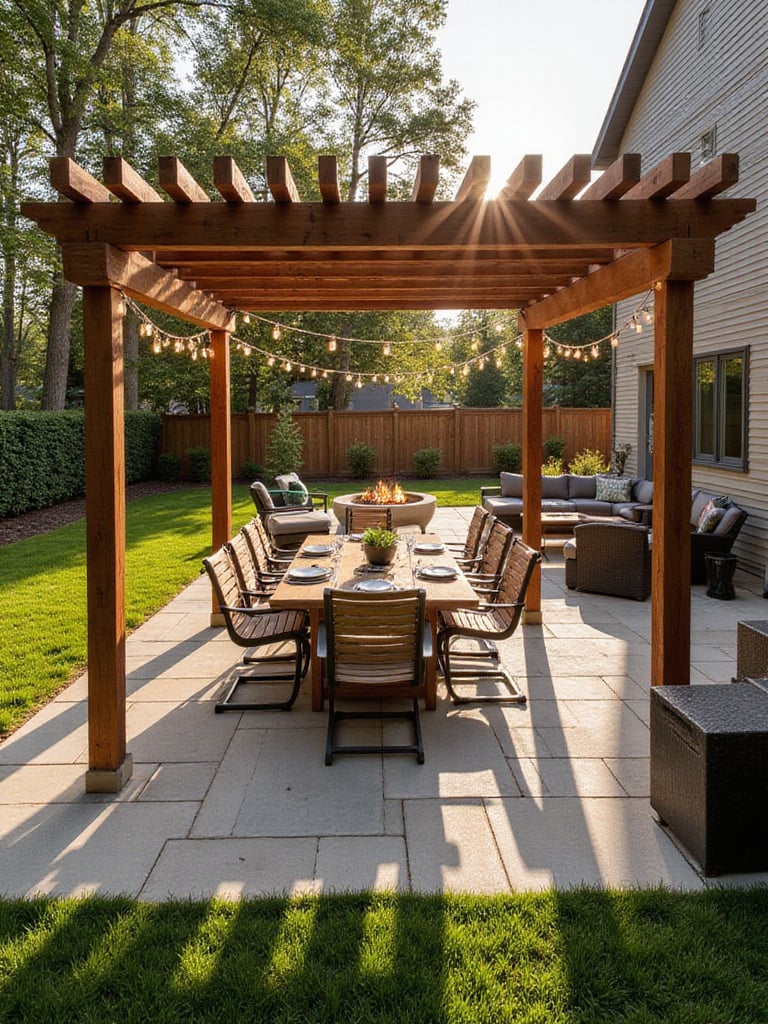
Having these distinct zones greatly enhances the usability of your entire outdoor area. Instead of a single, undefined space, you create dedicated areas for different activities. Imagine hosting a dinner party under a pergola-defined dining zone, while a separate, uncovered patio area becomes the perfect spot for pre-dinner drinks and conversation.
“A well-placed pergola creates an architectural transition between spaces, defining purpose without walls. It’s like having outdoor rooms without the constraints.” – Alexandra Winters
The surprising part is how a simple overhead structure can completely change how people use and experience your outdoor space. Ready to boost your home’s value? Let’s look at how a pergola can be a smart investment.
A well-designed patio pergola elevates your backyard from ordinary to extraordinary, creating an outdoor oasis that immediately catches the eye of potential buyers. It speaks to a lifestyle of relaxation and outdoor enjoyment, making your property more desirable compared to similar homes lacking such features. By clearly defining an Outdoor Dining Area, lounge space, or even an outdoor kitchen, you are essentially adding usable “rooms” to your home.

However, not all pergolas are created equal when it comes to adding value. The impact depends on several factors. High-quality materials like cedar or redwood signal durability and sophistication, adding more value than cheaper alternatives. Custom-built pergolas, designed to complement your home’s architecture, often have a greater impact than prefabricated kits. Size and placement matter too; a pergola that integrates seamlessly with your landscaping and patio design will be far more appealing.
Value-boosting pergola features: * High-quality, durable materials * Professional installation * Architectural compatibility with your home * Integrated lighting and electrical * Weather protection elements * Low-maintenance design
What complicates this is finding the right balance between investment and return. A luxury pergola may not pay off in all neighborhoods, while a basic structure might fall short in high-end areas. Let’s explore how a pergola can help you enjoy your patio throughout the changing seasons.
While a pergola’s open structure provides lovely dappled shade, its true versatility lies in its adaptability. By incorporating elements like retractable canopies, adjustable louvers, or even temporary enclosures, you can tailor your patio pergola to different weather conditions. Need protection from a sudden rain shower? Extend the canopy. Want to soak up the winter sun? Retract it.
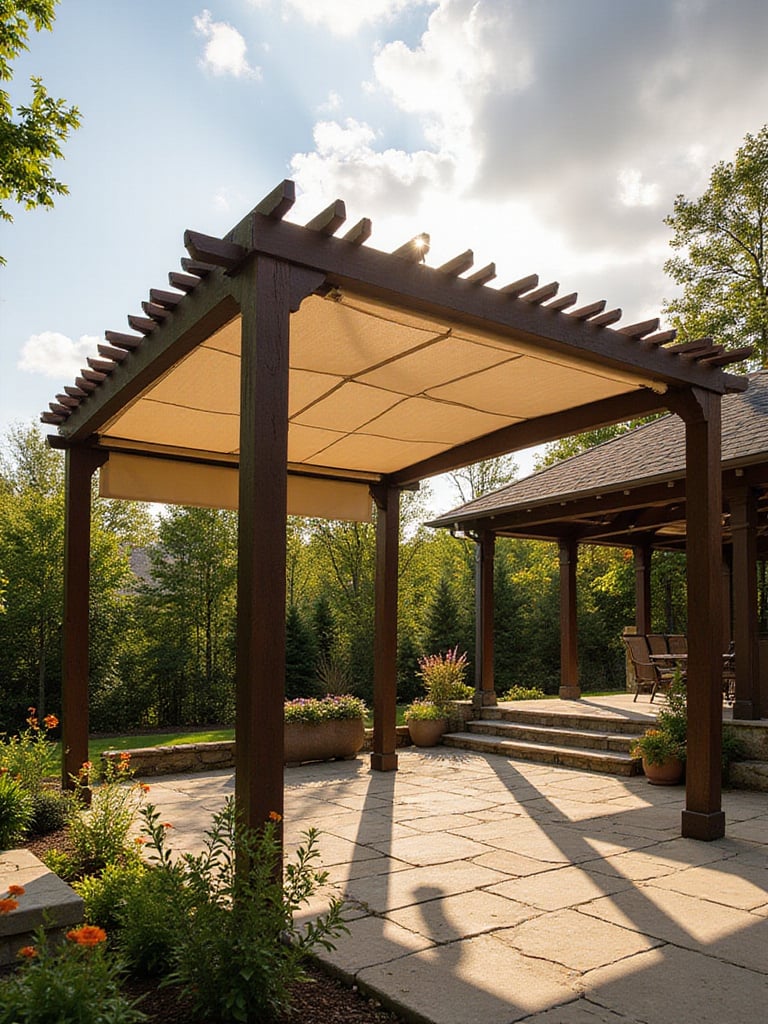
Choosing the right materials is key to all-season pergola protection. For sunny climates, shade cloth or aluminum louvers are excellent for sun control. In rainy areas, waterproof fabrics like acrylic canvas or polycarbonate panels offer reliable rain protection. For windy locations, ensure any additions are securely fastened. For the pergola structure itself, Weather-Resistant Materials like cedar, redwood, or aluminum are ideal for long-term durability.
Season-extending pergola additions: * Retractable waterproof canopies * Adjustable louvers for sun control * Outdoor curtains for wind protection * Integrated heating elements for cooler evenings * Outdoor fans for summer comfort
The game-changer happened as I added a retractable canopy to my own cedar pergola. Suddenly my patio wasn’t just a summer space—I found myself enjoying morning coffee outdoors well into fall and early spring. Beyond practical protection, let’s see how pergolas dramatically enhance visual appeal.
A pergola introduces architectural structure and visual interest to your backyard. It creates defined spaces, acting as a focal point and providing a sense of enclosure without feeling closed off. Its open framework is perfect for incorporating decorative elements like climbing plants and Outdoor Lighting, allowing you to customize the look and feel of your backyard.
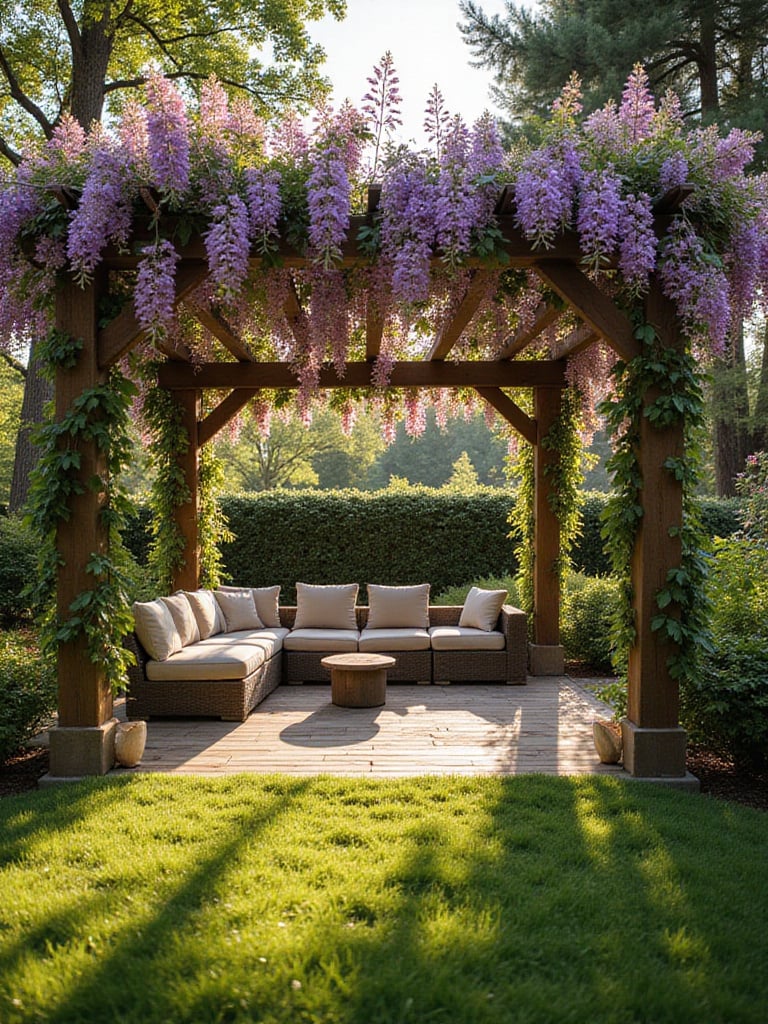
The design elements of a pergola are crucial to its aesthetic impact. The material – wood, metal, or vinyl – sets the tone. The style – clean lines for modern, ornate details for traditional – dictates the overall feel. Size and proportions are key to balance. Even the roof design, whether flat, gabled, or curved, contributes to the aesthetic. And don’t forget the details: the spacing of slats, the addition of climbing plants, the glow of outdoor lighting, and the selection of furniture all work together to create a cohesive design.
Picture it this way: a pergola is like jewelry for your landscape – it adds that finishing touch that transforms the ordinary into something spectacular. It frames views, creates visual rhythm, and adds architectural interest where there was none before.
Yearning for a more private outdoor experience? Let’s explore how pergolas can create a secluded retreat right in your backyard.
While pergolas are inherently open structures, they provide a fantastic framework for enhancing privacy on your patio. They act as a visual barrier, creating a sense of enclosure and separation from neighboring properties or busy streets. The overhead structure itself offers a degree of privacy, subtly defining your space and making it feel more intimate.
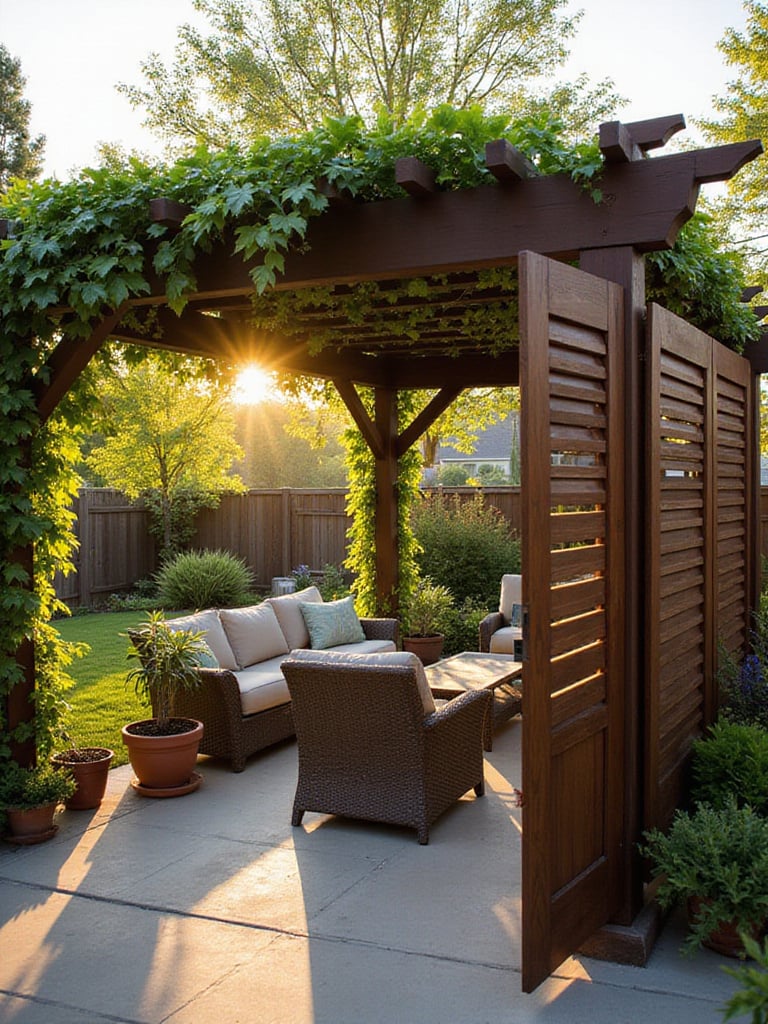
When it comes to privacy screens for pergolas, you have a wealth of options. Fabric screens, like outdoor-rated curtains, are affordable and create a soft, elegant look. Wooden slats or panels offer a more permanent and substantial privacy solution. Metal screens are durable and stylish, adding a modern touch. Climbing plants, like jasmine or wisteria, provide natural beauty and privacy. Bamboo screens offer an eco-friendly and visually appealing option with a tropical vibe.
Privacy enhancement options: * Retractable side curtains * Fixed decorative screens * Climbing plants on trellises * Slatted wooden panels * Outdoor-rated fabric panels
The tricky part is balancing privacy with light and airflow. Too much enclosure and you lose the airy feel that makes pergolas special. For a timeless and classic look, wood pergolas remain a favorite. Let’s explore their enduring charm.
The inherent appeal of wooden pergolas lies in the natural beauty of the material itself. Wood seamlessly blends with outdoor environments, creating a warm, inviting, and harmonious atmosphere. Its natural texture and grain add character and sophistication, enhancing the overall aesthetic of any patio. Furthermore, wooden pergolas offer a timeless aesthetic that transcends trends. Their simple yet elegant designs have remained popular for centuries.
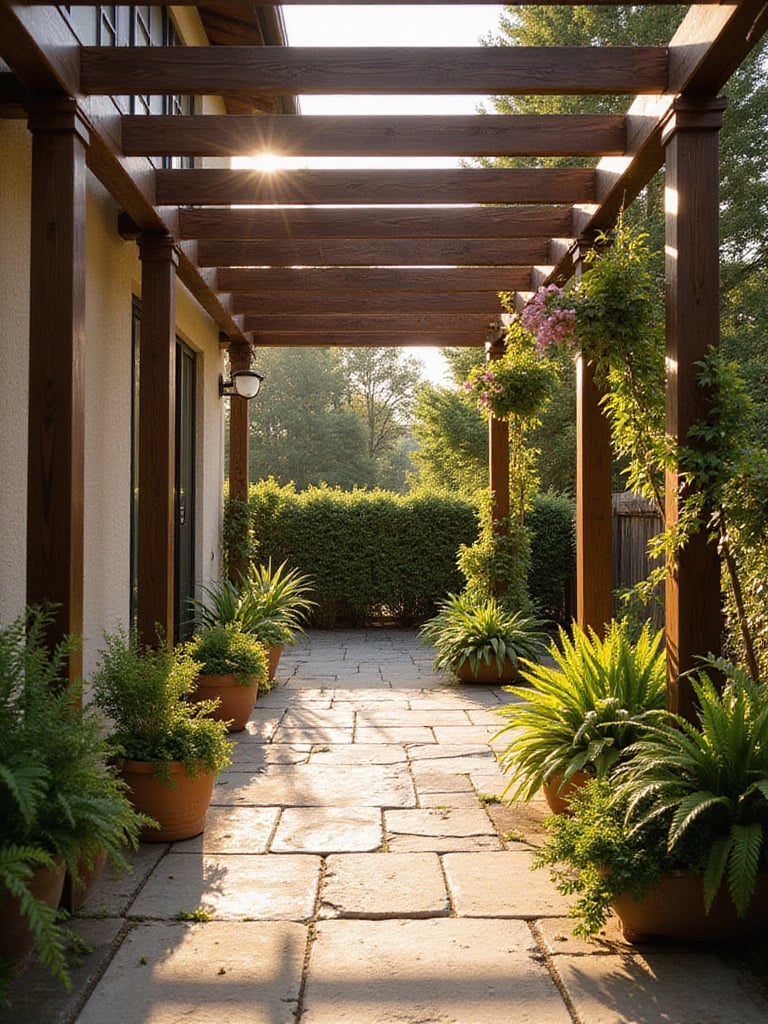
The key design elements of a classic wooden pergola contribute to its enduring appeal. Clean lines, sturdy posts, and evenly spaced rafters are hallmarks of this style. Substantial posts provide a sense of permanence and stability, while evenly spaced rafters create a visually appealing shade structure. Natural wood finishes, like stains or sealants, enhance the wood’s inherent beauty and protect it from the elements. Climbing plants, such as roses or wisteria, are often incorporated to add a touch of romantic charm and soften the structure’s lines.
“There’s something authentically luxurious about a wooden pergola that synthetic materials simply can’t replicate—the warmth, the texture, the way it ages with grace and character.” – Alexandra Winters
Let me paint you a picture… Imagine sitting under a cedar pergola on a warm summer evening, the wood glowing amber in the setting sun, the grain patterns telling stories of years of growth. For a more contemporary vibe, metal pergolas offer a sleek alternative. Let’s explore their modern appeal.
Metal pergolas are ideal for achieving a modern aesthetic due to their inherent characteristics. They offer clean lines and a minimalist look that aligns perfectly with contemporary design principles. Compared to wood, metal offers superior durability and requires minimal maintenance. No staining, painting, or sealing is needed, saving you time and effort. Metals like aluminum and steel are incredibly strong and resistant to warping, cracking, or fading, ensuring a long-lasting, pristine appearance.
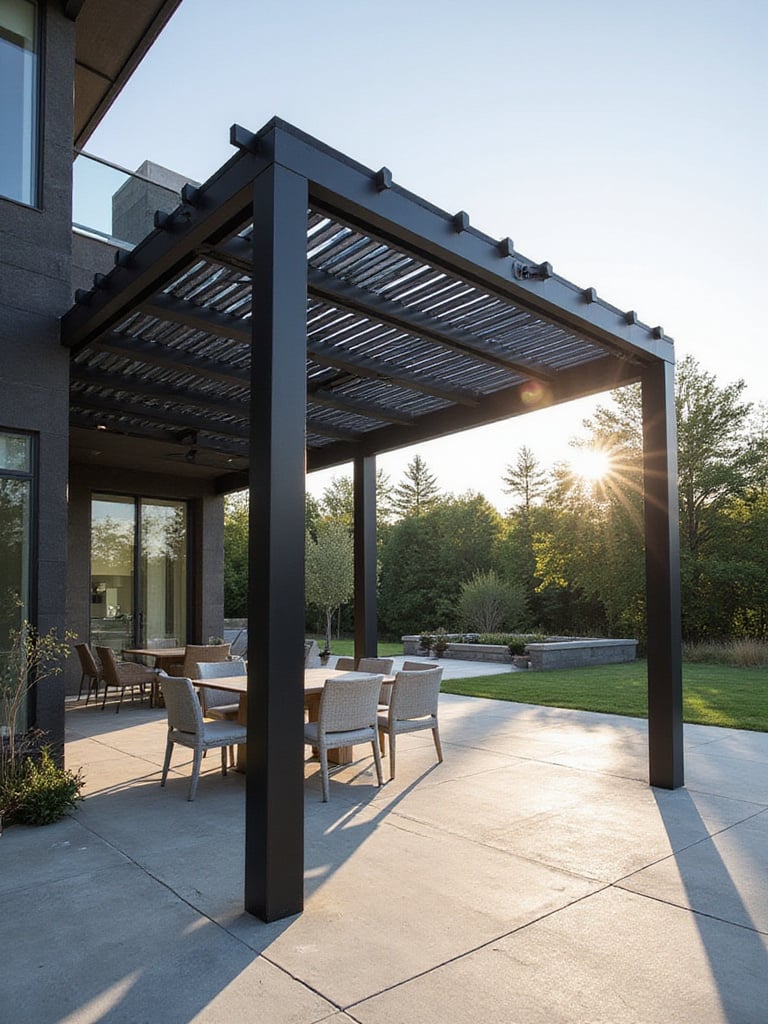
Aluminum and steel are the most common metals used for modern patio pergolas. Aluminum is lightweight, rust-resistant, and affordable, making it a great choice for coastal areas or DIY projects. Steel, especially galvanized or powder-coated steel, is exceptionally strong and durable, capable of supporting heavier loads and withstanding harsh weather. While heavier and potentially pricier than aluminum, steel offers unmatched robustness and longevity. Stainless steel is the premium option, providing superior corrosion resistance but at a higher cost.
Metal pergola styling tips: * Choose powder-coating colors that complement your home’s exterior * Add warmth with wood accents or fabric elements * Incorporate lighting that highlights the sleek lines * Contrast with soft textiles and lush plantings * Consider geometric or laser-cut decorative panels
Here’s the unexpected twist: metal pergolas can actually appear to “float” more than wooden ones due to their ability to span greater distances with thinner supports. Placement is key when it comes to pergolas. Let’s explore the decision between attached and standalone structures.
Attached pergolas, also known as wall-mounted pergolas, offer direct access from your home, creating a seamless transition from indoors to outdoors. They extend outward from an existing wall, typically your house, providing covered patio space right outside your door. Standalone pergolas, in contrast, are self-supporting structures, not connected to any building. This allows for placement anywhere in your yard or garden, offering greater flexibility in design and location.
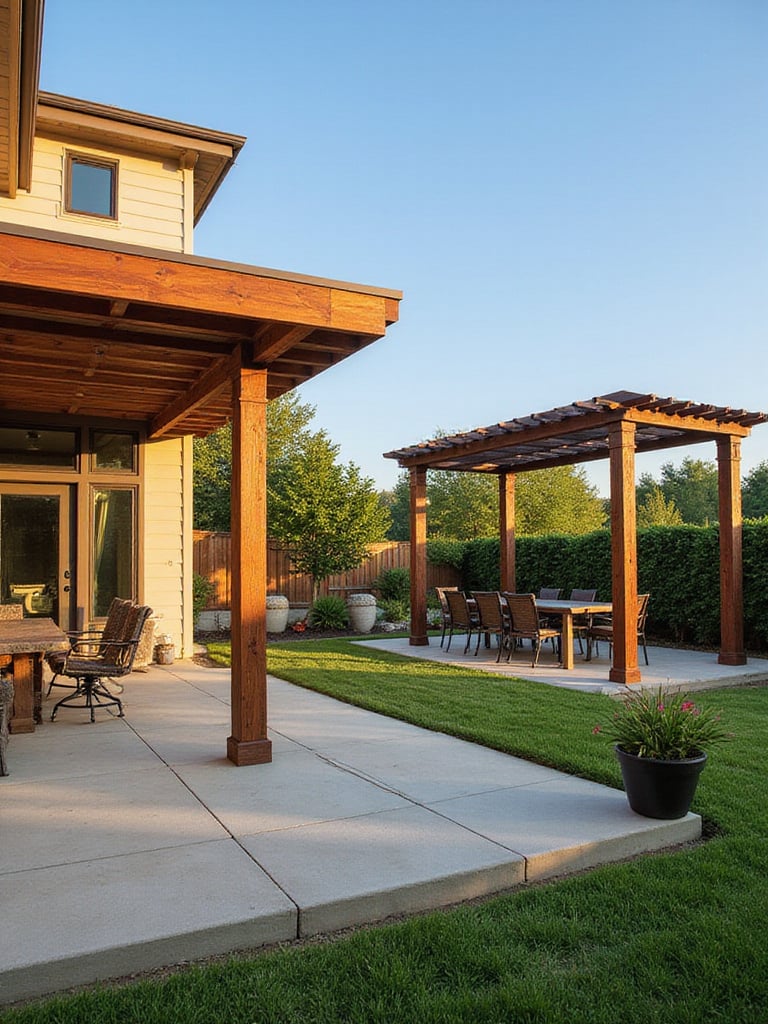
Attached pergolas boast several advantages. Convenience is a major perk, with easy access to your house, making them ideal for outdoor dining or entertaining. They are often more cost-effective to build, as they utilize your house’s existing structure for support. Attached pergolas create a seamless integration between indoor and outdoor living spaces, extending your home’s usable area. They also offer partial protection from rain and sun, especially when combined with a solid roof covering.
Benefits of standalone pergolas: * Complete design freedom * Can be placed to capture the best views * Creates a destination within your landscape * No structural impact on your home * Can be repositioned if needed (depending on design) * Often doesn’t require building permits (check local codes)
The heart of the matter is how you plan to use your pergola. An attached structure works beautifully for everyday living and entertaining, while a standalone creates a special destination in your yard. For ultimate control over shade, retractable canopy pergolas offer a fantastic solution.
The primary benefit of a retractable canopy pergola is the ability to control sunlight exposure. Fixed roof pergolas offer constant shade, which can be limiting. Retractable canopies give you the power to adjust the amount of shade based on the weather, time of day, or your personal preference. This flexibility extends the usability of your patio throughout the year. Enjoy sunshine on cooler days, and easily create complete shade during the hottest hours.

Retractable canopies come in a variety of materials and styles. Durable fabrics like acrylic canvas, vinyl-coated polyester, and waterproof materials are common choices. Operation can be manual, using a hand crank or pull cord, or motorized, controlled by a remote or smartphone app for ultimate convenience, especially for larger pergolas. Styles range from sliding panels to rolling canopies and pleated fabric systems, each offering a unique aesthetic and level of adjustability.
My breakthrough came when I installed a motorized retractable canopy on a client’s pergola in Phoenix. They went from using their patio maybe two months a year to enjoying outdoor living nearly year-round. The ability to adjust to changing conditions throughout the day transformed their relationship with their outdoor space.
Taking shade control even further, louvered pergolas offer precise adjustability. Let’s delve into their experience.
Louvered pergolas excel in providing superior control over sunlight and ventilation compared to traditional fixed-roof pergolas. The adjustable louvers allow you to fine-tune the amount of sun exposure, creating comfortable shade when needed while still allowing sunlight to filter through when desired. This adjustability also promotes natural ventilation, preventing heat buildup and ensuring better airflow underneath the pergola. When fully closed, the louvers offer enhanced protection from light rain.
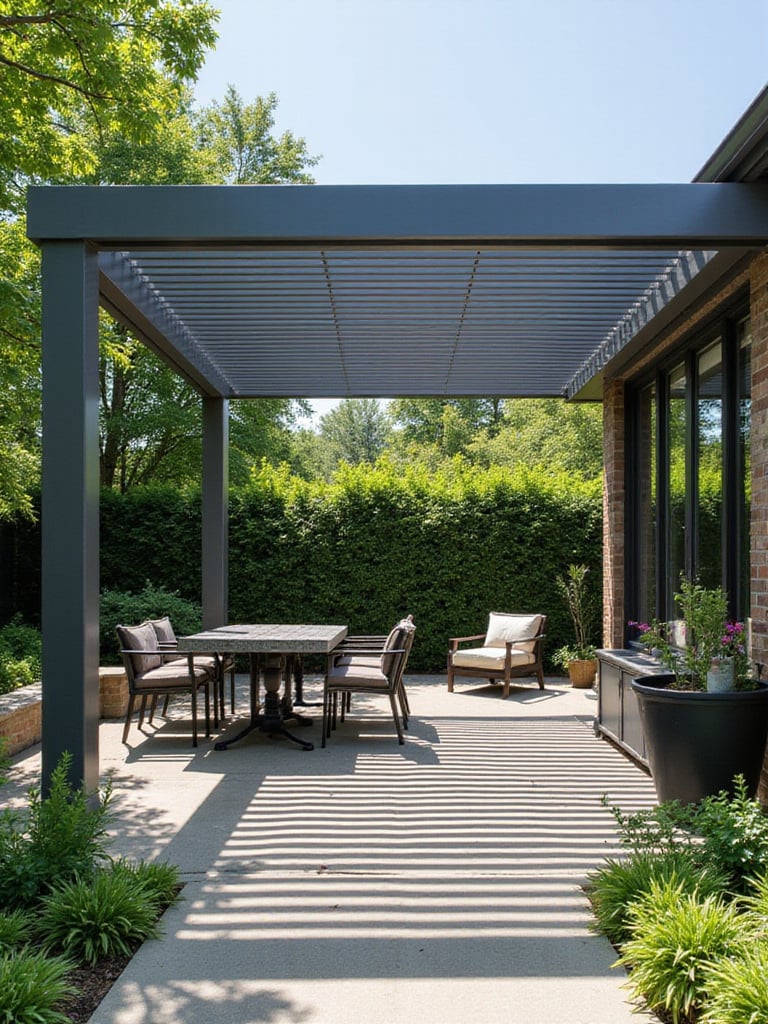
Louvered pergolas are commonly constructed from aluminum, steel, or wood, each material influencing durability and aesthetics. Aluminum is favored for its lightweight nature, rust resistance, and minimal maintenance, making it a durable and long-lasting option ideal for modern designs. Steel offers exceptional strength and can support heavier loads, but requires rust-proofing treatments like galvanization or powder-coating. Wood provides a natural, aesthetically pleasing look, particularly for traditional styles, but needs regular sealing and maintenance.
The angle of louvers can impact temperature by: * Fully closed: Up to 15°F cooler than ambient temperature * 45° angle: Filtered light with good airflow * Fully open: Maximum sunlight while maintaining architectural definition * Adjustable throughout the day to follow or avoid the sun’s path
Do you see how huge that is? Instead of a static structure, you essentially have a living roof that responds to your needs and the weather conditions. When choosing a wooden pergola, durability is paramount. Let’s explore the top wood choices for long-lasting structures.
Wood durability in outdoor structures hinges on several key factors. Natural resistance to decay and insect infestation (especially termites and carpenter bees) is crucial. The ability to withstand moisture, sunlight (UV damage), and temperature fluctuations is equally important. Wood density and the presence of natural oils also contribute to durability; denser woods with higher oil content tend to be more resilient in outdoor environments.
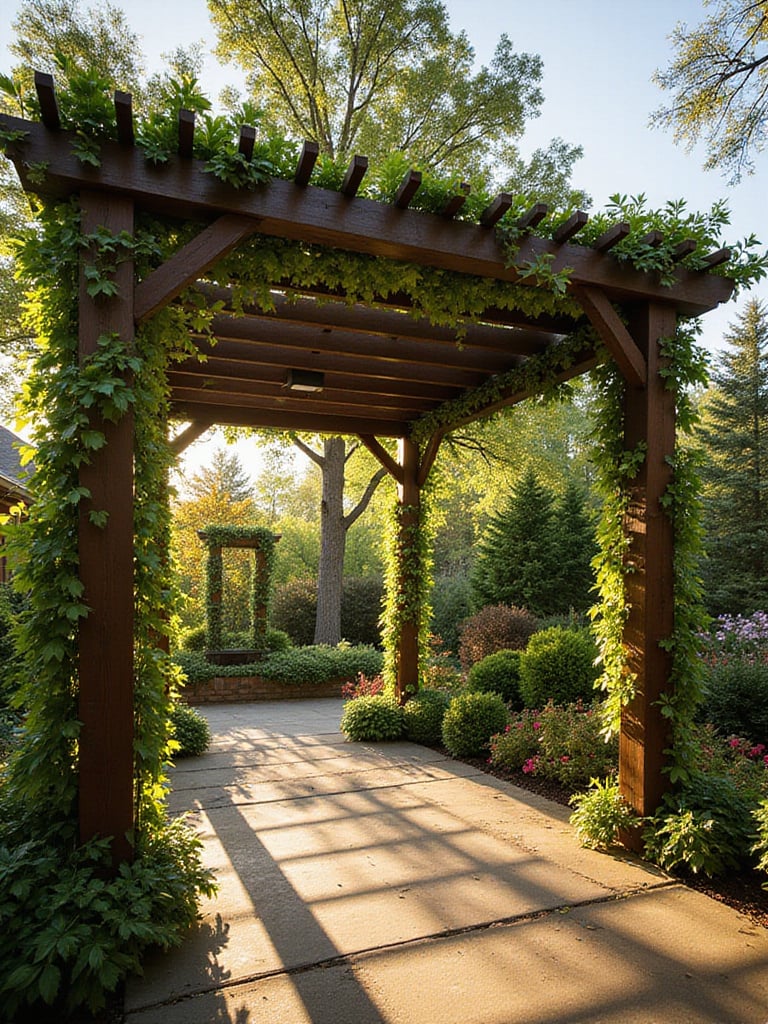
For pergola construction, several wood species are renowned for their durability and weather resistance. Redwood, naturally resistant to decay and insects, weathers beautifully to a silver-gray patina. Cedar (Western Red Cedar) shares redwood’s natural durability and insect-repelling properties, and is also lightweight and easy to work with. Teak, prized for its high oil content, is exceptionally durable and water-resistant, requiring minimal maintenance – a premium choice. Ipe (Brazilian Walnut), an incredibly dense and hard wood, offers exceptional resistance to decay, insects, and abrasion, making it ideal for high-traffic areas.
Premium wood options for patio pergolas: * Redwood: Natural beauty with excellent decay resistance * Cedar: Aromatic with natural oils that repel insects * Teak: The gold standard for outdoor durability * Ipe: Incredibly dense and hard-wearing * Black Locust: Sustainable domestic hardwood with excellent rot resistance * White Oak: Traditional choice with proven longevity
It works something like this: the denser the wood and the higher its natural oil content, the better it will withstand the elements. For homeowners seeking minimal upkeep, aluminum pergolas are an excellent choice. Let’s explore their effortless beauty.
Aluminum pergolas are prized for their exceptional low-maintenance nature. Unlike wood, aluminum is impervious to rot, warp, crack, or splintering, making it highly resistant to weather damage. It’s also immune to insect infestations, eliminating worries about termites or carpenter ants. Compared to vinyl, aluminum offers superior strength and resists sagging or bending over time. This translates to minimal upkeep – no painting, staining, or sealing is ever required, saving you significant time and money in the long run.
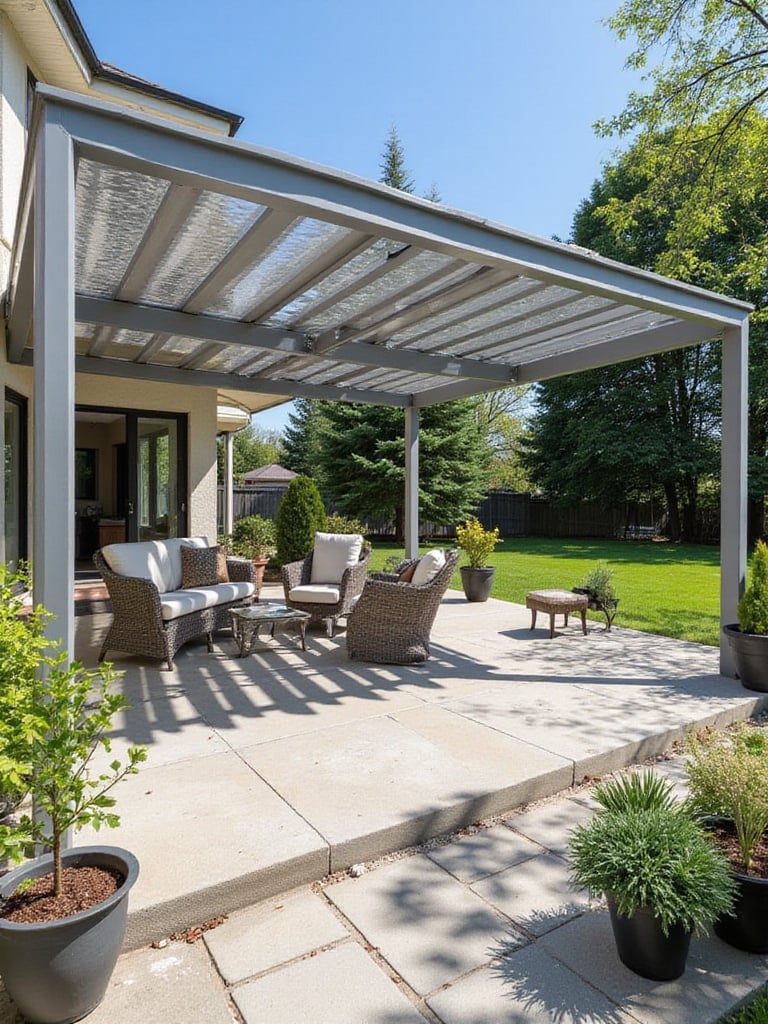
Aluminum pergolas are not just functional; they can be remarkably aesthetically pleasing. Modern manufacturing techniques allow for diverse designs, finishes, and colors to complement any outdoor style. You can even find aluminum pergolas with wood-grain finishes, capturing the warmth of wood without the maintenance burden. Powder coating provides a durable and attractive finish, customizable to match your home’s exterior. Aluminum’s inherent strength allows for sleek, modern designs with clean lines that are challenging to achieve with other materials.
What many people overlook is that aluminum pergolas can be a smart environmental choice too. They’re 100% recyclable, have a smaller carbon footprint than wood when sustainably manufactured, and their longevity means fewer replacements over time.
For unmatched strength and a bold aesthetic, steel pergolas are a powerful option. Let’s explore their robust elegance.
Steel pergolas offer significant advantages in strength and durability compared to wood or aluminum. They are exceptionally resistant to warping, rotting, insect infestation, and fire, ensuring a truly long-lasting investment. While aluminum is lightweight and rust-resistant, steel provides superior structural integrity, enabling larger spans and more intricate design possibilities. Steel’s inherent strength allows for sleeker, more minimalist designs that would be structurally unsound with weaker materials.
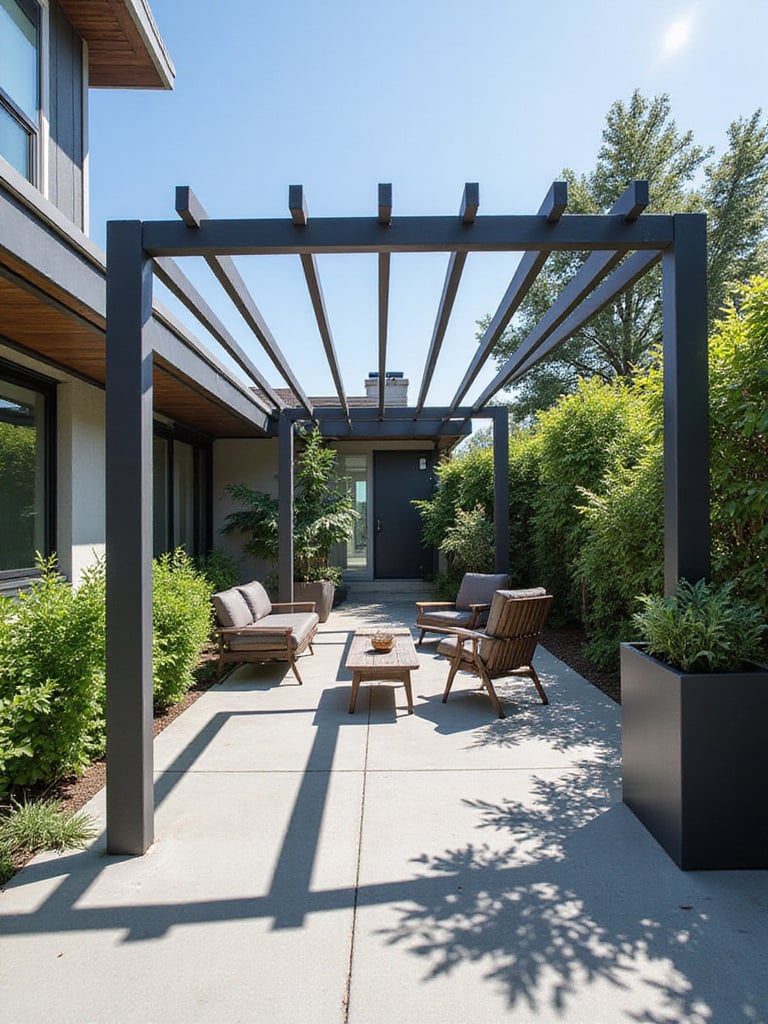
When incorporating a steel pergola into your outdoor space, thoughtful design considerations are key. Embrace steel’s inherent industrial aesthetic and consider how it will complement your home’s architecture and surrounding landscaping. Steel’s clean lines pair beautifully with modern and contemporary designs. Consider using contrasting elements, such as lush greenery or warm-toned furniture, to soften the inherent starkness of metal. Ensure the pergola’s size and scale are proportionate to your patio and surrounding area to maintain visual harmony.
“Steel pergolas can appear to float above a space in ways wood simply cannot. The strength-to-weight ratio allows for designs that seem to defy gravity, creating drama and architectural interest.” – Alexandra Winters
The missing piece is often the finish—powder-coating not only protects steel but allows for any color imaginable, from subtle earth tones that blend with the landscape to bold statements that make your pergola a focal point. Ready to dine al fresco? Let’s focus on pergolas designed to create perfect outdoor dining spaces.
A pergola elevates the outdoor dining experience by defining the space and creating a sense of intimacy, transforming a simple patio into a true outdoor dining room. It provides partial shade, shielding diners from harsh sunlight, light rain, and gentle breezes, creating a more comfortable and enjoyable dining environment. The pergola structure also offers opportunities to enhance the ambiance with lighting, plants, and decorative elements, further enriching the overall dining experience.
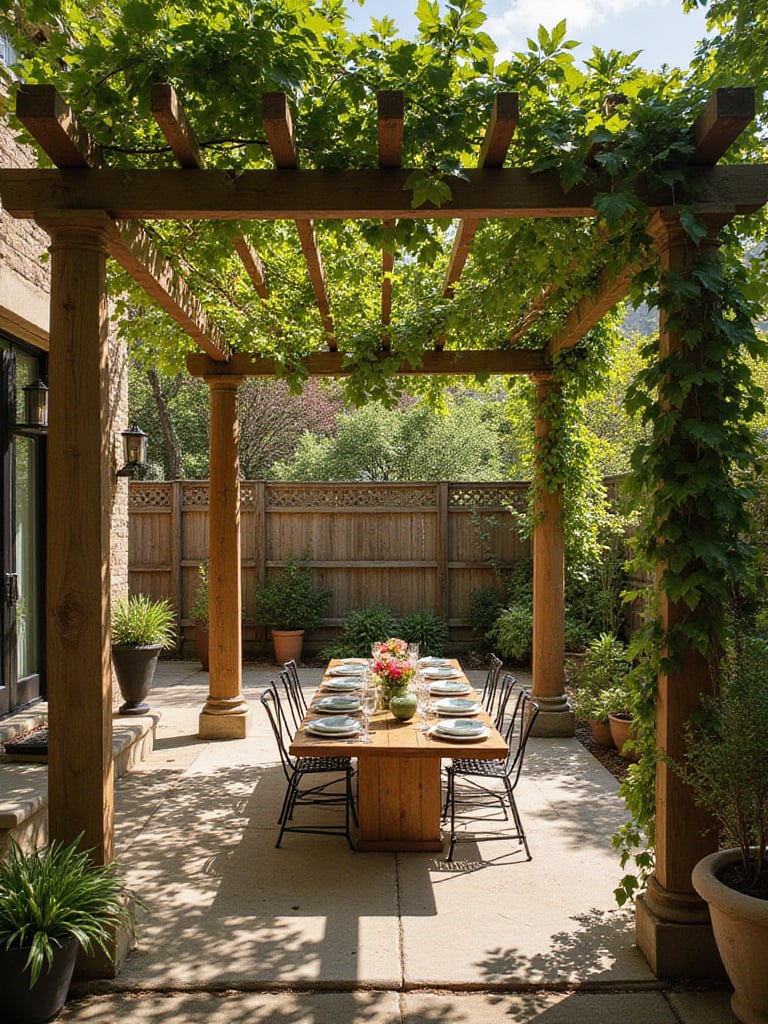
Key considerations when designing a pergola for outdoor dining include size and functionality. Ensure the pergola is sized to comfortably accommodate your dining table and chairs, allowing ample space for movement around the table while seated. The pergola’s height should be sufficient to prevent a cramped feeling. Material choices should complement your home’s exterior and withstand the elements. Consider adding functional features like built-in lighting for evening meals, ceiling fans for added comfort in warm weather, or retractable canopies for adjustable shade and rain protection.
Dining pergola dimensions guide: * 4-person table: minimum 10′ x 10′ pergola * 6-person table: minimum 12′ x 12′ pergola * 8-person table: minimum 14′ x 14′ pergola * Allow at least 3′ clearance around the table for chairs and movement * Minimum 7′ height for comfortable headroom
Things took an interesting turn when I designed a dining pergola with integrated lighting that mimicked stars in the night sky—small LED points embedded in the cross beams created a magical atmosphere for evening meals. For luxurious relaxation, pergolas are ideal for creating stylish patio lounge areas. Let’s explore how to unwind in style.
A luxurious pergola lounge area is defined by comfort and style, going beyond mere functionality. Key elements include high-quality, comfortable outdoor furniture, such as deep-seating sofas, plush armchairs, and perhaps a daybed or swing for ultimate relaxation. Soft textiles, like outdoor rugs to define the space, decorative throw pillows, and cozy blankets, enhance comfort and visual appeal. Ambient lighting, such as string lights, elegant lanterns, or integrated pergola lighting, creates a warm and inviting atmosphere, especially in the evenings.
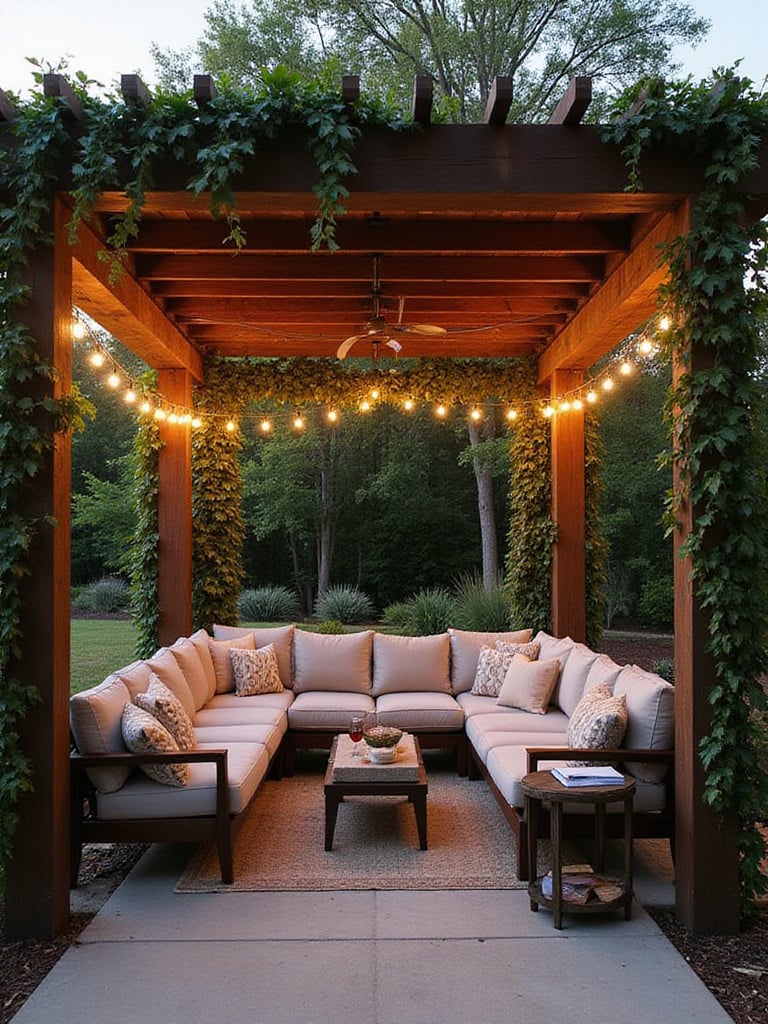
When selecting furniture for a luxurious pergola lounge area, durability and style are paramount. Premium materials like teak, powder-coated aluminum, and all-weather wicker are excellent choices, offering both longevity and sophisticated aesthetics. Teak is naturally weather-resistant and develops a beautiful patina over time, adding character. Powder-coated aluminum is lightweight, rust-proof, and available in a variety of colors to complement any design. High-quality all-weather wicker mimics the elegant look of natural wicker but is engineered to withstand the elements, ensuring lasting beauty and comfort.
Let me show you another perspective… Think of your lounge pergola as a luxury hotel cabana brought to your own backyard. The same principles of indulgent comfort, premium materials, and thoughtful details apply. The most successful lounge pergolas invite you to linger, to sink in and stay awhile.
Want to create a spa-like experience at home? Pergolas are perfect for covering hot tubs and spas in style and privacy. Let’s explore spa-tacular pergola ideas.
Covering your hot tub or spa with a pergola offers a multitude of benefits. Privacy is a primary advantage, shielding you from prying eyes and creating a more secluded and relaxing spa environment. A pergola also provides crucial protection from the elements, offering shade from harsh sunlight, shelter from rain, and even shielding from falling leaves or debris, making your spa experience more comfortable and enjoyable year-round, regardless of the weather. Furthermore, a well-designed pergola significantly enhances the aesthetic appeal of your outdoor space.

Important design considerations when building a pergola for a hot tub or spa include size, ventilation, style, and orientation. The pergola should be appropriately sized to provide ample coverage for the hot tub or spa and surrounding access area without feeling cramped. Adequate ventilation is crucial; ensure the pergola design allows for proper airflow to prevent moisture buildup and potential mold growth in the humid spa environment. Consider the architectural style of your home and existing landscaping to ensure the pergola complements the overall aesthetic of your outdoor space.
Hot tub pergola essentials: * Moisture-resistant materials like cedar, redwood, or aluminum * Adequate height clearance for removing covers * Privacy screens or curtains for seclusion * Non-slip flooring around the perimeter * Convenient hooks for towels and robes * Weatherproof lighting for evening use
The stumbling block is often moisture management—the combination of water splashes and steam requires careful material selection and proper ventilation. For the ultimate outdoor cooking experience, consider designing an outdoor kitchen under a pergola.
Planning an outdoor kitchen under a pergola requires careful consideration of several key factors. First, assess the pergola’s size and placement. It should be large enough to comfortably accommodate the desired kitchen area, including appliances, countertops, and prep space, while also providing adequate shade for comfortable cooking. Consider prevailing winds to minimize smoke and heat blowing towards your house or primary entertaining area. Next, carefully determine the necessary utilities: gas lines for grills or cooktops, water lines for sinks, and electrical outlets for appliances and lighting.
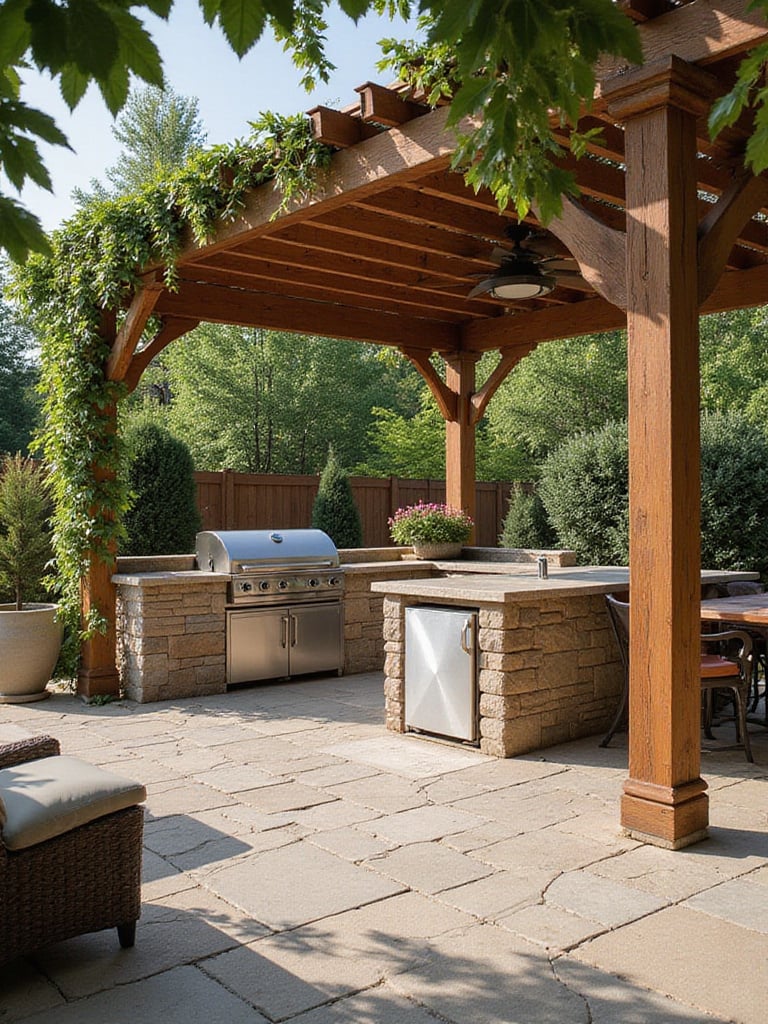
The best appliances and features for an outdoor kitchen under a pergola depend on your individual cooking style and entertaining needs. A high-quality built-in grill is a must-have for many outdoor cooks, while others may desire specialized appliances like a smoker, pizza oven, or side burner for expanded culinary options. Consider including a refrigerator or beverage center to keep drinks and food cold and readily accessible. A sink with running water is invaluable for food preparation, handwashing, and cleanup. Ample counter space is essential for prepping ingredients, plating dishes, and serving food.
Here’s the catch—outdoor kitchens under pergolas need to balance open-air cooking with adequate protection. Consider a design that includes a solid roof section over cooking areas while maintaining the open pergola feel elsewhere. This hybrid approach offers the best of both worlds.
Lighting is essential for extending the usability of your pergola into the evening hours. Let’s explore enchanting lighting ideas for your pergola.
As dusk settles, transform your patio pergola into a magical evening retreat with thoughtfully integrated lighting. Pergola lighting not only enhances safety and functionality but also creates a captivating ambiance, extending your enjoyment of your outdoor space long after sunset. String lights, including globe lights, fairy lights, and Edison bulb strings, offer a festive and whimsical ambiance, perfect for creating a relaxed and inviting atmosphere. Pendant lights, hung from the pergola beams, provide focused illumination and add a touch of elegance, particularly for dining areas.
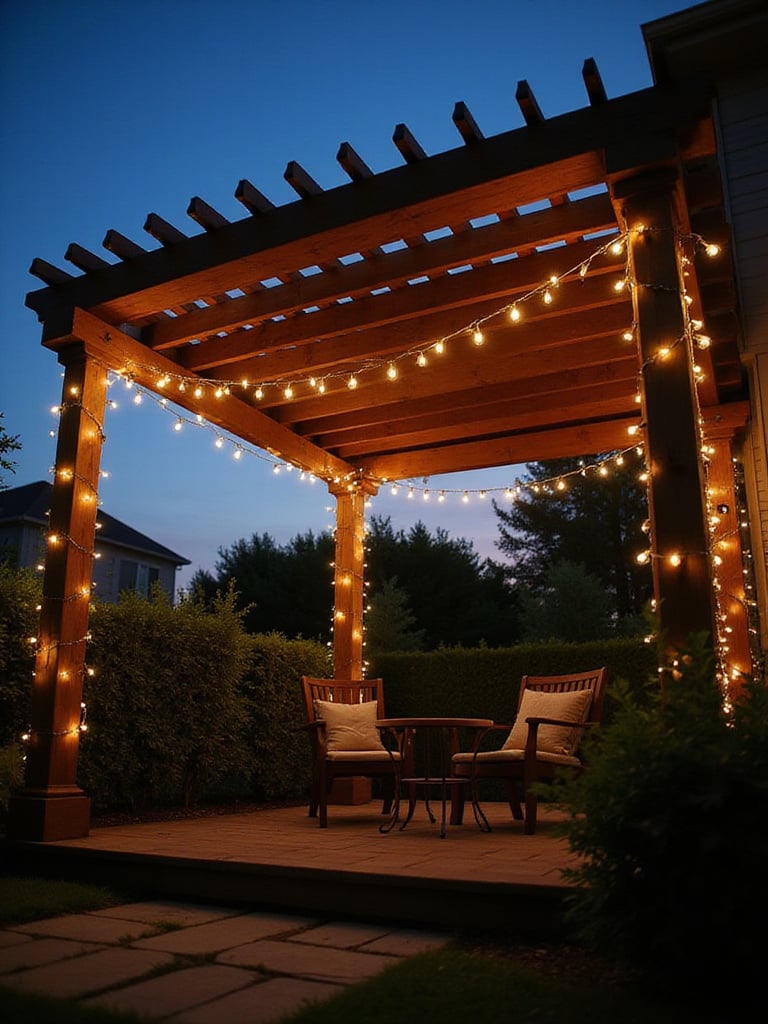
Controlling your pergola lighting allows you to customize the ambiance and functionality of your outdoor space. Simple on/off switches are the most basic and cost-effective control method. Dimmers provide greater flexibility, allowing you to adjust the brightness of the lights to create different moods for various occasions. Smart lighting systems offer advanced control and convenience, typically operated via smartphone apps or voice assistants. Smart systems enable features like scheduling lighting to turn on and off automatically at set times, changing colors for festive occasions (if using color-changing bulbs), and integrating with other smart home devices for seamless control.
Pergola lighting styles: * Romantic: Fairy lights and candle lanterns * Modern: Linear LED strips along beams * Classic: Wrought iron pendants or chandeliers * Festive: Colorful string lights or paper lanterns * Subtle: Recessed spotlights or uplighting * Dramatic: Color-changing LED systems
My experience went like this: I installed a combination of string lights for ambient glow and adjustable spotlights for task lighting in a client’s dining pergola. The transformation was remarkable—their outdoor dining season extended by months because they could comfortably use the space after dark. For a natural and verdant touch, adorn your pergola with beautiful climbing plants.
Transform your pergola into a living, breathing structure by adorning it with beautiful climbing plants. A green canopy not only adds stunning visual appeal but also provides natural shade, fragrance, and a touch of nature’s magic to your patio. Climbing plants dramatically enhance visual appeal and beauty, transforming a simple pergola structure into a lush, verdant oasis, softening hard lines and adding organic texture. Beyond aesthetics, climbing plants can improve air quality by absorbing pollutants and releasing oxygen.
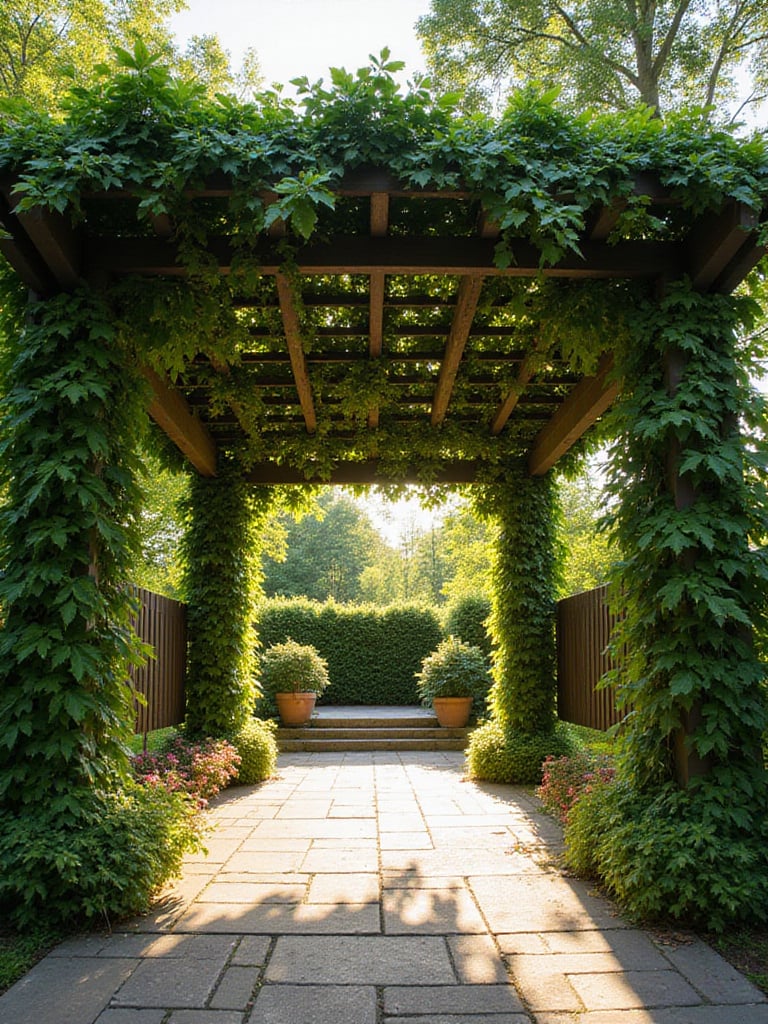
Numerous climbing plants are well-suited for pergolas, each offering unique characteristics and visual appeal. Wisteria is renowned for its fragrant, cascading blooms in spring, creating a dramatic and romantic effect. Climbing roses add classic beauty and romantic charm with their fragrant flowers and varied colors. Clematis offers a wide variety of colorful flowers in diverse shapes and sizes, along with interesting foliage, providing extended seasonal interest. Grapevines are not only visually appealing with their lush foliage and fruit clusters, but also offer practical benefits, providing dense shade and the potential for harvesting homegrown grapes.
Top pergola climbers by attribute: * Fastest growing: Silver lace vine, annual morning glory * Most fragrant: Jasmine, honeysuckle, some climbing roses * Best shade creators: Grapevines, kiwi vine, wisteria * Winter interest: Evergreen clematis, Carolina jessamine * Edible options: Grapes, kiwi, passionflower (passionfruit) * Low maintenance: Boston ivy, Virginia creeper
The potential here is enormous—a plant-covered pergola becomes a living ecosystem, attracting butterflies, hummingbirds, and beneficial insects while creating a microclimate underneath that can be 5-10 degrees cooler than surrounding areas. Choosing the right size pergola is crucial for creating a balanced and functional patio space.
When planning your patio pergola, size truly matters. Choosing the right dimensions is essential for ensuring your pergola is not only aesthetically pleasing but also functional and well-proportioned to your patio and home. Begin by accurately measuring the patio area you wish to cover with the pergola. Think about the type and size of furniture you plan to place underneath the pergola, whether it’s a dining table and chairs, a lounge set, or a hot tub, and ensure the pergola will provide adequate coverage for these items while allowing comfortable movement around them.
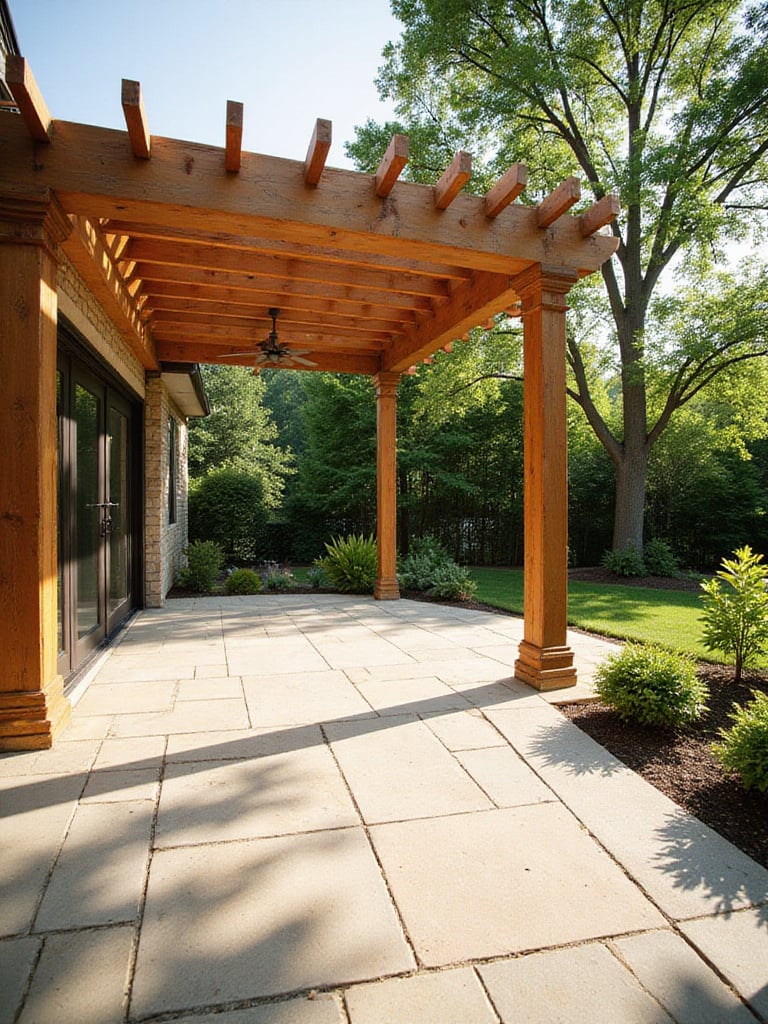
A pergola that is too small for your patio will feel cramped and visually insignificant, failing to provide adequate shade or shelter and potentially looking out of place on a larger patio. Conversely, a pergola that is too large can overwhelm the space, making your patio feel closed in and potentially blocking desirable natural light from entering your home’s windows. An oversized pergola can also be more expensive to build, require more maintenance, and may not be as aesthetically pleasing as a properly proportioned structure.
Pergola sizing quick guide: * Small intimate space: 8′ x 8′ to 10′ x 10′ * Medium dining area: 10′ x 12′ to 12′ x 14′ * Large entertainment space: 14′ x 14′ or larger * Height: Minimum 7’6″ clearance, typically 8′-10′ tall * Post thickness: 6″x6″ for most residential pergolas * Beam/rafter spacing: 12″-24″ depending on desired shade level
It’s kinda like Goldilocks—you want a pergola that’s “just right” for your space, not too big, not too small. The proper proportions create harmony with your home and landscape while ensuring functionality. Finally, personalize your pergola to truly make it your own.
Accessorizing your pergola is crucial because it transforms a functional structure into a personalized outdoor haven that reflects your individual tastes and lifestyle. It allows you to inject your personality, design preferences, and practical needs into the space, making it uniquely yours. This customization significantly enhances both the aesthetic appeal and the functionality of your patio, elevating it beyond a simple outdoor area and creating a truly enjoyable and personalized extension of your home.
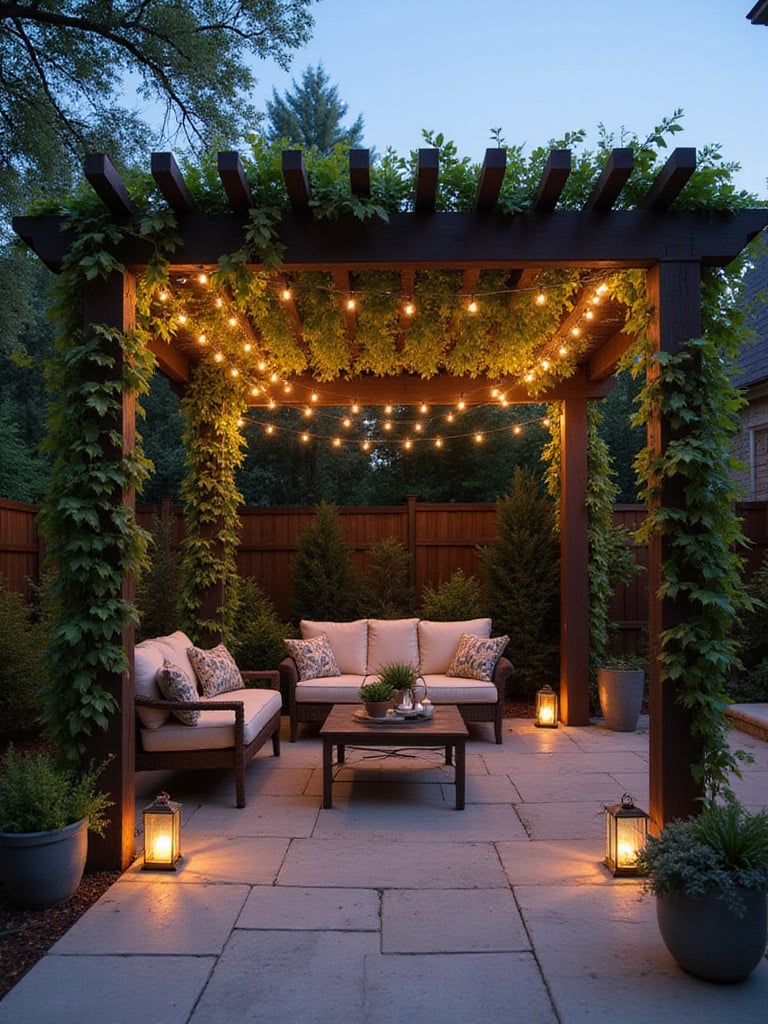
When personalizing your pergola, consider accessories across several key categories to create a well-rounded and stylish outdoor space. Think about comfort and seating first: choose outdoor furniture like sofas, armchairs, and perhaps a hammock or hanging chair, and enhance comfort with plush cushions and soft throws. Lighting is essential for evening ambiance: incorporate string lights for a festive glow, lanterns for a cozy touch, spotlights to highlight features, or pathway lighting for safety. Textiles and privacy are important for creating a secluded and comfortable space: consider curtains or shades for sun control and privacy, or stylish outdoor screens.
Ways to personalize your patio pergola: * Hang outdoor artwork or mirrors on posts * Add outdoor speakers disguised as rocks or planters * Install a ceiling fan for air circulation * Incorporate a water feature for soothing sounds * Hang bird feeders to attract wildlife * Add a fire element like a small tabletop fireplace * Display collections of lanterns or potted succulents * Install a projector and screen for outdoor movie nights
The ripple effects are enormous when you take the time to personalize. Your pergola becomes not just a structure but a destination—a place where memories are made and everyday moments become special.
From providing essential shade and defining outdoor zones to boosting home value and creating stunning aesthetics, patio pergolas are truly transformative additions to any outdoor space. Whether you embrace the timeless elegance of wood, the sleek chic of metal, or the customizable versatility of retractable canopies, the perfect pergola awaits to elevate your patio into a personalized paradise.
With endless design possibilities and accessory options, your pergola can become the heart of your backyard, a place for relaxation, entertainment, and connection with nature. The right pergola doesn’t just add a structure to your yard—it creates an experience, extending your living space and enhancing your lifestyle.
So, are you ready to take your patio to the next level? Start exploring these stunning pergola ideas and unlock the full potential of your outdoor living space today. Your perfect pergola paradise is waiting to be discovered.